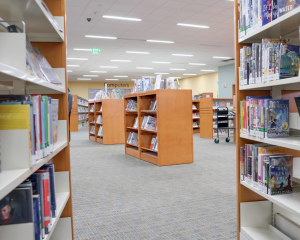
Lexington’s African American Heritage Walking Tour

Join us for an on-demand walking tour of Downtown Lexington’s African American heritage sites.

Join us for an on-demand walking tour of Downtown Lexington’s African American heritage sites.

Explore topics related to Science, Technology, Engineering, Art, and Math (STEAM) in this space for youth, grades 3-12.

Learn how the Lexington Public Library Foundation empowers change within our library system.

Learn or develop a personal or professional skill with LinkedIn Learning classes, available for free with your library card.

Did you know physical materials renew automatically if they don’t have a waiting list? Check your account online to see the status of your items.

The Undesign the Redline project unearths the deep and systemic history of structural racism and inequality in the United States. This interactive exhibit explores policies like Redlining, their implications for today, and what we can do to undesign them.
The exhibit was created by social impact design studio designing the WE and has been invited to dozens of cities across the country. A local advisory group has helped to produce local history and stories about Redlining in Lexington.
Exhibit open September 22 – November 17.
Redlining maps were introduced in the 1930s. Originally a federal policy, the maps were meant to show risk areas for federal backing of newly invented home ownership programs that would transform the American middle class.
The maps determined areas prime for investment and areas where no money would be lent. The neighborhoods where no investment would go were outlined in red. This shade was based almost entirely on race. They referred to these areas as “infiltrated” by “hazardous populations.”
Redlining was how structural racism was designed into cities. It shifted segregation from visible superstructure to ubiquitous infrastructure: further isolating communities even while ‘colored only’ signs came down. Soon without access to banking, insurance, or even healthcare, these marginalized groups were forced on a path of “urban decay,” accelerated by programs like Urban Renewal and Slum Clearance.
By many means, this American geography became a machine for reproducing a racially and class divided society. Investment drained from concentrated ‘inner city’ zones of poverty, mostly comprised of people of color, while investment poured into the rapidly expanding wealthier, whiter suburbs. This type of structural, geographic design alters what is possible in the decades that follow.
We still need to undesign Redlining. Today, even when money flows back into once-Redlined zones, the tide of investment cannot raise all boats. It washes people away. Broad wealth building still does not reach those of us who have been historically devalued. Instead, we are faced with a legacy of lingering bias, living with the scarlet letter of Redlining, and its cross-generational effects on wealth, income, well-being, and ownership.
Join Lexington Public Library and our partners, the Lexington Public Library Foundation, the University of Kentucky Office of Community Engagement, and Blue Grass Community Foundation, this fall to read The Color of Law by Richard Rothstein. In The Color of Law, Rothstein makes the case that racial segregation is the result of de jure practices, such as Redlining, and gives numerous examples of how the government at all levels created and enforced residential racial segregation.
The intent of this community read is to bring our community together to learn, grow, have a shared experience, and hopefully be motivated to act.
To browse related books and Ted Talks, click here.
The exhibit will open September 22 and close November 17. You can take a self-guided tour during library hours, or join us during one of the times below for a guided tour with a docent.
Tuesdays at 10am
Thursdays at 2pm
Saturdays at 10am
Sundays at 2pm
Have a group larger than 10? Please reach out to schedule your tour at visit@lexpublib.org.
To download a printable calendar of events related to Undesign the Redline, click here.
Special thanks to Lexington’s Undesign the Redline Advisory Committee, who have dedicated their time to bringing this exhibit to our community and shedding light on the history of Redlining in Lexington.